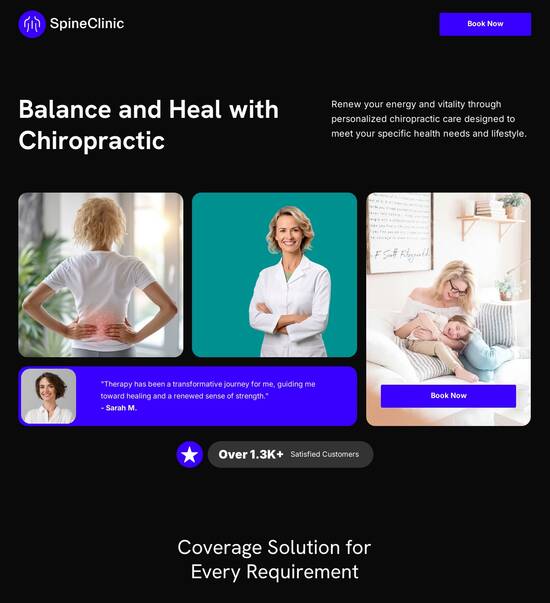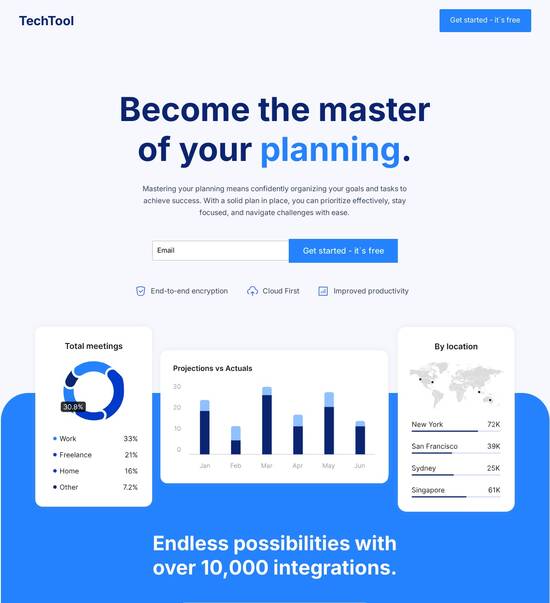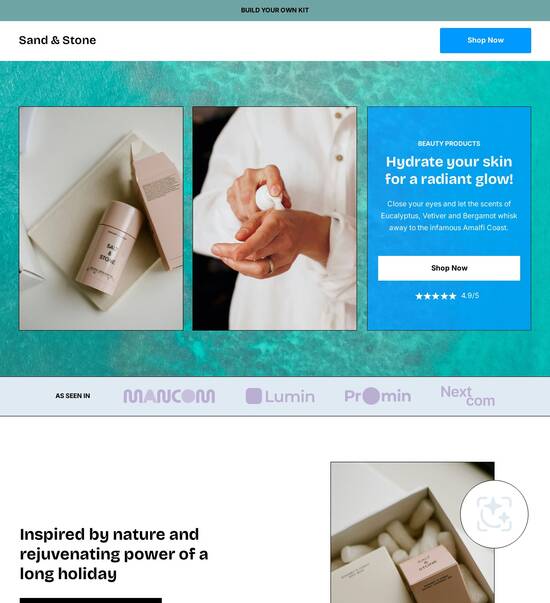
Vue.js optimized one page website template
Explore Similar TemplatesAbout template
Design your online journey with our Vue.js-optimized one page website template.
Recommended templates

Easy to build without coding
With the intuitive drag-and-drop builder, anyone on your team can create high-converting pages without any knowledge of code or design. Make enhancements to your landing page with custom widgets using Javascript, HTML/CSS, or third-party scripts.

Multiple layouts for any industry and goal
Select from 500+ landing page layouts built to boost conversions across industry-specific scenarios. Customize them by adjusting fonts, adding images, and generating on-brand content with the AI assistant. Quickly scale with Instablocks® and Global Blocks that you can save, reuse, and update globally.

Loads fast and looks polished on any device
Every template is responsive, which means they present professionally on any device and load blazingly fast with our Thor Render Engine. You can also power them up with Google AMP technology to deliver an unparalleled mobile experience and drive higher conversions.

Robust analytics & experimentation
Get real-time updates and reporting across all your devices, showing the number of visitors, conversions, cost-per-visitor, and cost-per-lead. Launch AI-powered experiments, run A/B tests, and use heatmaps to analyze user behavior, then optimize your landing page to maximize conversions.







Easy to build without coding
With the intuitive drag-and-drop builder, anyone on your team can create high-converting pages without any knowledge of code or design. Make enhancements to your landing page with custom widgets using Javascript, HTML/CSS, or third-party scripts.
Multiple layouts for any industry and goal
Select from 500+ landing page layouts built to boost conversions across industry-specific scenarios. Customize them by adjusting fonts, adding images, and generating on-brand content with the AI assistant. Quickly scale with Instablocks® and Global Blocks that you can save, reuse, and update globally.
Loads fast and looks polished on any device
Every template is responsive, which means they present professionally on any device and load blazingly fast with our Thor Render Engine.
Robust analytics & experimentation
Get real-time updates and reporting across all your devices, showing the number of visitors, conversions, cost-per-visitor, and cost-per-lead. Launch AI-powered experiments, run A/B tests, and use heatmaps to analyze user behavior, then optimize your landing page to maximize conversions.
All the features you need to build lead-generating landing pages
Explore more featuresLearn how to build top-performing landing pages for any goal
FAQs
Leading the way in building high-performing landing pages





A comprehensive guide to Instapage's powerful landing page optimization platform
As digital marketing continues to evolve, optimizing landing pages is crucial for maximizing ROI. Instapage is renowned for its user-friendly interface and a myriad of high-converting templates, allowing marketers and businesses to build landing pages seamlessly without needing any coding expertise.
Understanding Instapage's Landing Page Functionality
Instapage takes the complexity out of creating effective landing pages. With over 100 customizable templates, marketers can easily adapt designs to fit specific campaign requirements. This not only saves time but also enhances the overall user experience for prospective customers.
- Customization options: Tailor your landing pages with drag-and-drop features, ensuring everything from layout to lead generation elements align with your brand's identity.
- Seamless integration: Instapage connects with various tools like CRM systems and email marketing platforms, ensuring smooth transitions between capturing leads and following up.
- Mobile responsiveness: All templates are designed to be mobile-friendly, ensuring optimal performance across devices, which is essential in today's mobile-driven market.
Step 1: Designing Your Landing Page
Begin by selecting a template that resonates with your campaign goals. With Instapage’s vast library, finding a model that fits your message is straightforward.
Step 2: Optimizing for Conversions
Utilize Instapage’s built-in tools to refine your page for maximum engagement. Key actions include:
- A/B Testing: Run multiple versions of your landing page to see which elements resonate more with your audience, allowing data-driven decisions.
- Analytics Dashboard: Leverage tools like heatmaps to better understand user interactions and make necessary adjustments to enhance user experience.
- Dynamic Text Replacement: Personalize messages to align with user intent—ensuring that visits feel tailored and relevant.
Step 3: Collaborate and Launch
Once you have built your landing page, leverage Instapage's collaboration features to involve your team in real-time edits and feedback. This ensures that everything is polished before you hit publish.
- Feedback loops: Easily gather insights from team members by enabling comments directly on the page.
- Version control: Track changes and revert to previous versions if necessary, ensuring you maintain the best performing setup.
- Stakeholder reviews: Share your landing page with external parties securely for their input without compromising your site's security.
In summary, Instapage empowers marketers to create effective landing pages that not only attract but also convert visitors, making it a leading solution in today’s digital landscape.
Ready to boost your campaign results? Start using Instapage today and experience the difference in lead generation and conversion rates.
People also ask about Vue.js optimized one page website template
Optimizing efficiency: The power of Vue.js for one page website templates
Understanding Vue.js and its significance in web development
Vue.js is a progressive JavaScript framework that has garnered significant attention in the realm of web development. It is designed to create user interfaces and single-page applications (SPAs) with a focus on simplicity and flexibility. Vue.js allows developers to build interfaces and manage the interaction between the user and the application seamlessly. One of its key characteristics is its reactivity, which means any changes in the model will automatically update the view.
The framework features a component-based architecture, breaking down applications into encapsulated components. This modularity not only enhances code maintainability but also promotes reusability throughout the project. Developers appreciate Vue.js for its gentle learning curve and well-structured ecosystem, making it suitable for both beginners and seasoned professionals.
Lightweight: Vue.js is smaller in size compared to other frameworks like Angular and React, contributing to faster load times.
Flexible: Integration with various projects is straightforward, allowing developers to incrementally adopt features.
Strong community: A vast number of resources and plugins are available, facilitating easier troubleshooting and faster development.
Why choose Vue.js for one page websites?
One-page websites have become increasingly popular as they provide a seamless user experience that caters to modern web design trends. Vue.js is an ideal choice for these single-page applications as its reactivity allows for smooth transitions and interactions, significantly enhancing the user experience. Because all content is contained on a single page, it reduces loading times and navigational delays, creating a more fluid experience.
Vue.js’s component-based architecture means that developers can create reusable components, making it easier to manage the application’s structure and maintain code quality. This modularity extends to styling and behavior, allowing developers to modularize their CSS and JavaScript effectively. Overall, the combination of Vue.js with one-page websites results in a lightweight, efficient, and user-friendly product that meets contemporary expectations.
The rise of single page applications (SPAs)
Single-page applications have become a leading trend due to their ability to provide instant feedback and a reduced load time compared to traditional multi-page websites. Users expect websites to load quickly and respond immediately to their inputs, which is where SPAs excel. The content is dynamically updated without needing full-page reloads, allowing for a more engaging experience.
Furthermore, SPAs are efficient in utilizing caching and managing browser history, often leading to improved SEO and user retention. Many marketers and developers aim to enhance conversion rates by leveraging SPAs, as they deliver a streamlined experience that minimizes friction during navigation. As a result, businesses across various verticals—from e-commerce to education—are increasingly adopting this model.
Crafting an optimized one page template with Vue.js
When designing an optimized one-page template with Vue.js, it’s crucial to include essential components that cater to user needs while enhancing aesthetic appeal. A well-structured template includes a header for navigation and branding, a main content section that effectively conveys key information, and a footer for contact details and additional links. These components should be designed to create a seamless flow as users scroll through the page.
Vue Router can be invaluable for managing navigation between sections, providing smooth scrolling and transitions. An organized file structure ensures that the various components are optimized for loading, helping to maintain quick response times as users interact with the site. This method requires careful planning to ensure that the Vue components are not only visually appealing but also functional and efficient.
Header: Incorporate clear navigation links and branding elements to establish identity.
Main Content: Provide well-organized information that leads visitors through the site.
Footer: Include essential links, contact information, and social media icons.
Template structure: best practices
Creating a robust template structure is paramount when optimizing a Vue.js one-page website. Developers should utilize Vue’s native capabilities, such as Vue Router, to facilitate navigation and manage page transitions. This not only improves the user experience but also enhances the website’s performance. Organizing components based on functionality and loading strategies can significantly boost load times and reduce choppiness during user interactions.
To achieve a truly responsive design, consider leveraging CSS frameworks like Tailwind CSS or Bootstrap. These frameworks come with pre-designed components and utilities that streamline the process of creating mobile-optimized layouts. Additionally, implementing media queries is essential for adjusting font sizes, images, and overall layout based on various screen sizes, ensuring that users enjoy a consistent experience across devices.
Feature analysis: unique capabilities of Vue.js one page templates
One of the standout attributes of Vue.js is its ability to enhance speed and performance. Techniques such as lazy loading components ensure that only the essential parts of the website are loaded initially, improving load times significantly. This approach not only offers a swift experience for users but also reduces unnecessary data loading, ultimately optimizing the website’s overall performance.
Using Vuex for state management further elevates performance by keeping state management centralized and efficient. The community's ecosystem around Vue has also led to a variety of libraries focused on enhancing performance, allowing developers to address any performance bottlenecks proactively, keeping their one-page sites running smoothly.
Dynamic content loading via API integration to keep your website fresh.
Animations and transitions powered by Vue’s capabilities, adding charm to interactions.
SEO techniques using Vue Meta for managing meta tags and improving search engine visibility.
Interactivity and user engagement
Vue.js empowers developers to create richly interactive one-page websites that effectively engage users. By leveraging dynamic content loading through API integration, developers can implement features such as live feeds, comment sections, or product displays that update in real time without reloading the page. This capability not only enhances user engagement but also helps maintain attention, increasing the likelihood of user conversion.
Additionally, the use of animations and transitions available in Vue allows for a visually appealing experience. These effects can guide users through the various sections of the page, creating a smoother interaction. While these elements improve the aesthetic of the site, they also provide cues for navigation, enhancing the overall user experience.
Template variants: exploring diverse offerings
The versatility of Vue.js allows for diverse one-page templates tailored to various use cases, catering to different audiences. For instance, personal portfolios shy away from excessive clutter, opting for simple and elegant designs that highlight individual work or achievements. Conversely, business landing pages prioritize conversion, focusing on clear calls-to-action and streamlined navigation to drive user engagement.
For event promotional sites, the design must be both informative and visually appealing, often integrating countdowns and ticket purchase functionalities. These templates can leverage the strengths of Vue.js to provide a seamless user experience. Furthermore, the capacity for customization allows developers to create unique experiences by enabling user personalization through configuration files or theme switching, helping align the template with branding requirements.
Personal portfolios: Showcase individual work effectively.
Business landing pages: Driving conversions with minimal friction.
Event promotional sites: Enhance user experience with seamless scrolling.
Your needs addressed: selecting the right template
When embarking on the creation of a Vue.js one-page website, it’s vital to assess your project requirements thoroughly. Start by identifying the primary purpose of the website—whether it’s for showcasing a portfolio, driving e-commerce sales, or promoting an event. Understanding your target audience and their specific needs will inform numerous design decisions, ensuring the final product aligns well with users’ expectations.
The decision between custom versus pre-built templates is another important consideration. Custom-built solutions provide complete control over functionality and aesthetics, but they often require additional development time and resources. In contrast, pre-built templates can significantly reduce development time and usually come with supportive documentation and community insights, making them an appealing option for many marketers and businesses.
Identify primary website purpose: Portfolio, E-commerce, or Event promotion.
Evaluate target audience and content needs to drive design choices.
Decide between custom or pre-built templates based on resources and requirements.
Code insights: understanding the backend
Understanding the code structure of Vue.js one-page templates is essential for maintaining and optimizing the product. Developers should focus on organizing Vue components logically, grouping related functionalities together while ensuring a clean separation of concerns. This organized approach not only aids in code readability but also makes collaborative work more efficient, as team members can easily navigate through the code.
Moreover, key libraries and plugins can significantly enhance functionality. For instance, integrating libraries for form validation, state management (Vuex), and routing (Vue Router) can streamline the development process. To debug and enhance template performance, utilizing Vue Devtools is invaluable, allowing developers to inspect component hierarchies and data flow effectively.
Organize Vue components: group related functionalities for clarity.
Use key libraries and plugins to enhance code functionalities.
Utilize Vue Devtools for effective debugging and performance monitoring.
Pricing and support: budgeting for success
When selecting a Vue.js one-page template, evaluating costs is crucial. Various templates may come with different pricing tiers contingent on the complexity of designs and available features. Free templates may provide essential functionalities, but premium options often include additional features, ongoing updates, and better support, which can translate into a better return on investment.
Understanding the importance of post-purchase support cannot be overlooked. Many template providers offer user support to assist customers in navigating functionality issues and related queries. Regular updates based on user feedback, bug fixes, and compatibility adjustments with new Vue versions can ensure the longevity and relevance of the template in the ever-evolving web development landscape.
Assess varying costs of template licenses to find a budget-friendly option.
Evaluate cost-benefit ratios of free vs. premium options for optimal value.
Prioritize templates with solid post-purchase support and regular updates.
Long-term value: the promise of lifelong updates
Focusing on long-term value is essential when investing in a Vue.js optimized one-page template. Continuous updates based on user feedback and adapting to emerging trends can play a significant role in keeping a template relevant. This adaptability ensures that businesses can rely on the template as they scale their web presence without worrying about obsolescence.
Future-proofing your template involves establishing a foundation for scalability and maintainability. It’s beneficial to select templates that can incorporate new technologies or methodologies, which is pivotal in a fast-paced digital environment. Engaging with the community surrounding Vue.js also enhances this process, as it opens up opportunities for learning and collaboration that can strengthen your template’s robustness.
Monitor user feedback and trends for continuous updates and improvements.
Establish scalable and maintainable foundations to future-proof your template.
Engage with the Vue.js community for insights and collaboration opportunities.
The path forward: embracing innovation with Vue.js
As web development continually evolves, staying ahead of the curve is integral for creators working with Vue.js. Regularly monitoring industry trends and emerging technologies will allow developers to implement new features or methodologies, enhancing their one-page websites. Collaborating within the Vue.js community can provide shared knowledge and best practices, ensuring that developers stay equipped to optimize their projects.
Furthermore, harnessing user feedback is essential for ongoing improvements. Gathering data about user interactions and preferences can guide refinements and feature developments. This iterative approach not only assures users that their needs are being acknowledged but also fosters ongoing innovation that keeps the template aligned with market demands.
Regularly monitor industry trends for insights on new features and methodologies.
Collaborate within the Vue.js community for best practices and shared knowledge.
Gather user feedback for continuous iterations and improvements.
Ready to skyrocket conversions?
Supercharge your ad campaigns with high-performing landing pages
Get started














